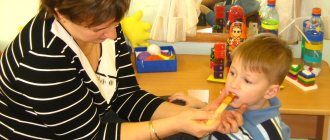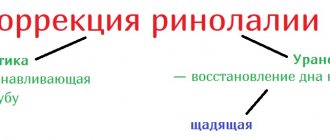Dysgraphia is a written language disorder. Signs and symptoms of deviation, treatment and methods of prevention - what parents of schoolchildren should know.
Children who have just started learning to write try to write neatly. However, the handwriting of most primary school children is clumsy and illegible. Many people write with errors because they do not yet know the basic rules of the Russian language. A child's written speech improves over time, but some children continue to write sloppily, changing letters in places, missing spaces and in the right places. There are a number of signs that should cause parents to become concerned and take their child to see a speech therapist, as they may be symptoms of dysgraphia.
Timely treatment of this disorder is the key to the fact that the child will have competent written speech in the future. That is why it is important to know what dysgraphia is, what its causes and main symptoms are, as well as how this deviation is treated.
What it is
Dysgraphia is a violation of written speech skills when partial difficulties arise in mastering writing. Characteristic signs are persistent, repeated errors in writing that are not related to the acquisition of spelling norms.
Dyslexia is a disorder in the development of reading skills. It is associated with difficulties in the formation of speech components and improper operation of analyzer systems.
Some experts believe that these disorders are not just pathologies, but a gift that you need to know how to use. They are not an indicator of low intelligence - these difficulties can occur in children with normal mental development. During diagnosis, it is important to determine whether it is dysgraphia and dyslexia, or physiological errors that are the norm when learning written language.
Prevention
The development of written and speech disorders can be prevented long before the start of the school program. To do this, parents need:
- be attentive to your health during the planning stages of your future child;
- eliminate bad habits of the mother during pregnancy, prevent infectious diseases;
- do not overload preschoolers with developmental activities, clubs, and additional classes;
- pay enough attention to home learning the basics of the Russian language, show the child the letters, teach them to pronounce words correctly;
- monitor the baby’s oral speech, correcting speech errors in a timely manner;
- avoid a lack of communication: read to the baby, tell stories, stimulate his speaking skills;
- do not distort words when communicating with a small child, abusing baby talk.
Parents also need to bring their baby for medical examinations in a timely manner, not ignore measures to prevent dangerous infectious diseases, and pay enough attention to general physical development and improving fine motor skills.
If your child has obvious problems with written language, and they do not improve as skills are honed, do not delay in contacting a specialist. Speech therapists and doctors at the SM-Doctor clinic examine the little patient and prescribe special classes to correct the problem.
Etiology of defects
Difficulties in mastering reading and writing skills are due to a number of organic or social reasons:
- Organic damage and underdevelopment of the cortical areas of the brain involved in the process of reading and writing.
- Immaturity of the cortical areas involved in the formation of written speech.
- Somatic weakness of the child.
- Incorrect speech environment in which the child grows up.
- Speech disorders.
- Bilingualism.
- Unfavorable social situation in the family.
Depending on the etiology of the violation, a corrective work plan is drawn up. By eliminating the cause of the reading and writing disorder, you can correct the defect itself. Each form of these violations has its own specific causes, on the basis of which correctional work is based.
How to fix a defect
The work of a speech pathologist is aimed at eliminating identified writing defects. Speech therapy exercises allow you to:
- improve pronunciation and diction;
- develop phonemic awareness (the ability to recognize individual phonemes in oral speech and syllables in written speech);
- enrich vocabulary;
- develop grammatical skills;
- develop coherent storytelling skills.
Correction of dysgraphia is impossible without improving the ability to perceive and analyze other people's speech (oral and written), navigate in space, develop memory and fine motor skills.
After practicing speaking skills, they move on to consolidating them in writing. If the cause of dysgraphia is a somatic disease, medication, physiotherapy, massage and exercise therapy are required.
Clinical symptoms
The manifestations of dysgraphia and dyslexia are varied, so it is very important to distinguish these disorders from physiological errors in the acquisition of written language. These disorders may be part of more complex neuropsychiatric diseases: mental retardation, mental retardation, etc. The clinical picture is represented by neurological and speech symptoms:
- Impaired coordination of movements.
- Difficulties in remembering rules and rhymes, read words.
- Lack of understanding of what is read and written. In this case, intelligence can be preserved.
- Problems with concentration and distribution of attention, switching it.
- The child confuses the sides.
- While reading and writing, discomfort occurs in the eyes (they may water, there may be pain; the child may bring the book too close or lean too low towards the notebook).
- In the process of reading and writing, the student quickly gets tired and may get a headache.
- The student tries to read and write less; refusals can manifest themselves in the form of negative reactions: aggression, crying.
- The child confuses similar elements.
- Incorrect pronunciation and violation of sound-letter analysis.
The main signs are errors in reading and writing, which differ in specificity. If a child has physiological errors that appear when mastering literacy, then when memorizing the rules, they go away. And with dysgraphia and dyslexia, they are persistent and recurring.
Mechanism of occurrence, causes
Writing is a process that requires the coordinated work of the visual, auditory, speech and motor systems. By the time the child masters the basics of writing, he should have mastered oral speech well. If the lateralization of brain functions is not carried out as needed, then a disorder such as dysgraphia develops. Usually these processes are normalized by the time the child begins school.
If the delay in lateralization causes disturbances in a part of the brain, the child develops dysgraphia, which requires correction. Otherwise, the deviation may affect the child’s thinking, memory, and perception.
Causes of occurrence in children
Dysgraphia can be caused by birth trauma. The development of such deviations is provoked by various infectious diseases and improper upbringing. Also, experts do not exclude such a factor as genetic predisposition.
Dysgraphia in children may be accompanied by other concomitant diseases that were previously diagnosed.
Causes of occurrence in adults
In adults, imperfections in written speech can be caused by both internal and external factors. Main reasons for deviation:
- presence of a tumor in the brain;
- low saturation;
- stroke;
- previous brain surgery;
- poor social conditions.
Social factors include insufficient upbringing in childhood, incorrect speech of people around, and lack of communication with others.
With dysgraphia, errors in the process of writing are persistent, despite the fact that the person knows well all the rules of writing words.
Classification of dysgraphia
There are many classifications of writing disorders. One of the most common, which is based on psychophysiological patterns in the formation of writing skills:
- If the child’s speech-auditory analyzer system is disrupted, this is an acoustic form. The reason for its appearance is the insufficient formation of phonemic processes. Acoustic dysgraphia manifests itself in the form of replacement and confusion of letters in writing. A student confuses letters whose phonemes have similar acoustic characteristics.
- If the functioning of the speech motor unit is disrupted, then an articulatory-acoustic form of dysgraphia may occur. A student confuses letters in writing whose phonemes have similar articulatory characteristics. If a child has incorrect sound pronunciation, then in elementary school most students pronounce the letters silently, which can lead to this form of dysgraphia.
- When the functioning of the visual, spatial and kinesthetic analyzers is disrupted, an optical-spatial form appears. The student has difficulty distinguishing sounds by ear, and the spatial orientation of the letter or its elements is disturbed. The child has difficulty determining the boundaries of sentences and text, seeing lines, etc.
Any of these forms can arise as a consequence of a speech disorder. Therefore, when constructing correction work, it is important to select exercises to correct the defect.
Kinds
Taking into account the nature of the disorders, the following types of dysgraphia are distinguished in children and primary schoolchildren:
- agrammatic, caused by an underdeveloped lexico-grammatical level, when the child confuses cases, suffixes, genders, and incorrectly uses endings and declensions;
- articulatory-acoustic, associated with disorders of articulation, sound reproduction and auditory perception;
- acoustic, caused by incorrect recognition of phonemes by ear, when the baby confuses paired sounds and changes, for example, “Z” to “S”, “D” to “T”;
- optical, the cause of which is underdeveloped visual-spatial perception, and then the child loses part of the letter (for example, instead of “SH” he writes “I”) or adds non-existent elements to the symbols;
- dysgraphia, caused by imperfect analysis and synthesis, when children swap the endings and beginnings of words, confuse syllables, rearrange or omit letters.
In isolated form, each type of disorder is extremely rare; in most cases, schoolchildren have a mixed type of pathology, and the causes can be both organic and socio-psychological at the same time.
What are the mistakes when the writing process is disrupted?
Dysgraphic errors are caused not only by the underdevelopment of analytical systems, but also by problems associated with the structural features of the speech defect.
- Mixing letters based on similar characteristics.
- Skipping a letter because the student “forgot” how to write it.
- "Mirror" writing of a letter.
- Skipping letter elements.
- Kinetic errors.
Depending on the type of errors, exercises are selected to correct writing disorders.
Consequences in the absence of correction
Ignoring problems with dysgraphia can cause serious problems, such as:
- inability to fully master the school curriculum, especially the subjects “Russian language” and “literature”;
- difficulties with written surveys;
- intellectual retardation due to failure to master school knowledge;
- anxiety;
- suspiciousness;
- communication problems with peers and classmates;
- low self-esteem;
- deviance of behavior.
The need to write something will cause discomfort and fear in the child. There may be problems with mathematical terms and others.
Classification of dyslexia
In modern speech therapy there are a large number of classifications of reading disorders. One of the most frequently used is the one proposed by R.I. Lalaeva. She created it taking into account reading disorders:
- With insufficient development of phonemic and phonetic-phonemic processes, a phonemic form of dyslexia appears. The student does not have a clear sound image of the letter. This manifests itself in the replacement and mixing of letters during reading. There may also be a violation of the syllabic structure of the word.
- Optical dyslexia is caused by insufficient development of the visual analytical system and optical-spatial representations. While reading, the student makes mistakes in letters that have similar optical characteristics. He has difficulty mastering the visual image of a letter and the arrangement of elements.
- The mnestic form is associated with the complexities of speech memory processes, manifested in the correlation of phoneme and letter images. A child cannot remember a letter and its components for a long time.
- When a child reads but does not understand the meaning of what he read, this is a manifestation of semantic dyslexia, also known as rote reading. A student may have an ideal reading technique, but he cannot establish semantic connections between words. Or if he reads syllable by syllable, he cannot understand what word he is talking about and cannot correlate it with a suitable picture.
- When the grammatical structure of speech, morphological and syntactic categories is insufficiently formed, an agrammatic form appears. Its characteristic features are incorrect endings, violation of word agreement norms, difficulties in word formation; incorrect accent placement.
- The tactile form is caused by a malfunction of the spatial analyzing system. This dyslexia can only occur in blind children who use Braille.
The described forms are rarely found in their pure form. Usually it is a combination of several types. And you need to select exercises to eliminate all errors that arise during reading.
What is dysgraphia and how to deal with it?
01/17/2019 The problem of written language disorders in schoolchildren is one of the most pressing topics, since writing and reading become the basis and means of further learning.
Written speech is one of the forms of existence of language, secondary, later in time than oral speech. Partial disorder of reading and writing processes is designated by the terms “Dyslexia” and “Dysgraphia”.
To understand the mechanisms of occurrence of these violations, it is necessary to understand what controls the processes of reading and writing, where all the threads are collected, along which the command goes to do this or that.
The process of developing writing is complex.
It involves four analyzers:
- speech motor, which helps to carry out our pronunciation;
- auditory speech, which helps to select an unnecessary phoneme;
- visual, which selects the appropriate grapheme;
- motor, with the help of which the grapheme is translated into kineme (Reproduction of a visual image using hand movements).
Only with coordinated work of all analyzers, with the preservation of certain brain structures, will successful mastery of written speech be ensured.
Dysgraphia
is a partial specific writing disorder.
The reasons for this violation may be different. Some are associated with the influence of internal factors (for example, long-term somatic diseases, pathology of pregnancy, childbirth, asphyxia, a “chain” of childhood infections), which lead to minimal brain dysfunction (MCD), general speech underdevelopment (GSD), mental retardation ( ZPR). Other reasons are associated with external factors: incorrect speech of others, lack of speech contacts, bilingualism in the family, insufficient attention to the child’s speech development on the part of adults. All this delays the formation of mental functions involved in the writing process.
As a rule, one can talk about manifestations of dysgraphia already in the middle of 1st grade, but a speech therapist can give an official conclusion only by the end of 1st grade.
In speech therapy, there are five forms of dysgraphia:
1. Articulatory-acoustic form of dysgraphia
Its essence is as follows: A child who has a violation of sound pronunciation, relying on his incorrect pronunciation, records it in writing. In other words, he writes as he pronounces. Such errors will remain in the writing until the sound pronunciation is corrected; it is impossible to correct the writing based on pronunciation.
Let me give you an example. The child is studying in the 7th grade, writing
2. Acoustic form of dysgraphia
This form of dysgraphia manifests itself in the substitution of letters corresponding to phonetically similar sounds. At the same time, in oral speech, sounds are pronounced correctly. In writing, letters are most often mixed, indicating voiced - unvoiced (B-P; V-F; D-T; Zh-Sh, etc.), whistling - hissing (S-Sh; Z-Zh, etc.). ), affricates and components included in their composition (CH-SH; CH-TH; C-T; C-S, etc.).
It also manifests itself in the incorrect designation of the softness of consonants in writing: “pismo”, “lubit”, “hurt”, etc.
3. Dysgraphia due to impaired language analysis and synthesis
This is the most common form of dysgraphia in children suffering from written language disorders. The following errors are most typical for it:
1. omissions of letters and syllables;
2.rearrangement of letters and (or) syllables;
3.underwriting words;
4. writing extra letters in a word (this happens when a child, while pronouncing while writing, “sings the sound” for a very long time;
5. repetition of letters and (or) syllables;
6.contomination - syllables of different words in one word;
7. continuous writing of prepositions, separate writing of prefixes (“on the table”, “on stepped”).
4. Agrammatic dysgraphia
Associated with underdevelopment of the grammatical structure of speech. The child writes ungrammatically, i.e. as if contrary to the rules of grammar (“beautiful bag”, “happy day”). Agrammatisms in writing are noted at the level of words, phrases, sentences and text.
Agrammatic dysgraphia usually manifests itself from the 3rd grade, when a student who has already mastered literacy “closely” begins to study grammatical rules. And here it suddenly turns out that he cannot master the rules of changing words according to cases, numbers, and gender. This is expressed in incorrect spelling of the endings of words, in the inability to coordinate words with each other.
5. Optical dysgraphia
Optical dysgraphia is based on insufficient development of visual-spatial concepts and visual analysis and synthesis. All letters of the Russian alphabet consist of a set of the same elements (“sticks”, “ovals”) and several “specific” elements. Identical elements are combined in different ways in space and form different letter signs: i, w, c, sch; b, c, d, y... If a child does not catch the subtle differences between letters, then this will certainly lead to difficulties in mastering the outline of letters and to incorrect representation of them in writing.
Errors most common in writing:
— underwriting of letter elements (due to underestimation of their number):
L instead of M; X instead of F, etc.;
— adding extra elements;
- omissions of elements, especially when connecting letters that include the same element;
- mirror writing of letters.
What you need to pay special attention to:
1.If your child is left-handed.
2. If he is a retrained right-hander.
3. If your child attended a speech therapy group.
4. If the family speaks two or more languages.
5. If your child went to school too early (learning to read and write unjustifiably earlier sometimes provokes the occurrence of dysgraphia and dyslexia.) This happens in cases where the child has not yet reached the psychological readiness for such learning.
6. If your child has problems with memory and attention.
7. Mixing letters by optical similarity: b-p, t-p, a-o, e-z, d-u.
8. Errors caused by impaired pronunciation, the child writes what he says: leka (river), suba (fur coat).
9. With impaired phonemic perception, the vowels o-u, e-yu, consonants r-l, y-l, paired voiced and voiceless consonants, whistling and hissing, sounds ts, ch, shch are mixed. For example: tynya (melon), klyokva (cranberry). 10. Missing letters, syllables, missing words. For example: prta - desk, moko - milk, cheerful (cheerful).
Some tips for parents:
1. If a child is assigned to read a text at home or write a lot, then break the text into parts and complete the task in several steps.
2. Do not force your child to rewrite homework many times; this will not only harm the child’s health, but also instill in him insecurity, and also increase the number of mistakes.
3. Praise your child for every success achieved, humiliate him as little as possible.
A FEW EXERCISES to help overcome dysgraphia
Exercise "Proofreading".
For this exercise you need a book, boring and with a fairly large (not small) font. The student works every day for five (no more) minutes on the following task: crosses out the given letters in a continuous text. You need to start with one letter, for example, “a”. Then “o”, then the consonants with which there are problems, first they also need to be asked one at a time. After 5-6 days of such classes, we switch to two letters, one is crossed out, the other is underlined or circled. The letters should be “paired”, “similar” in the student’s mind. For example, as practice shows, most often difficulties arise with the pairs “p/t”, “p/r”, “m/l” (spelling similarity); “y/d”, “y/y”, “d/b” (in the latter case the child forgets whether the tail of the circle is pointing up or down), etc.
The pairs required for development can be established when viewing any text written by your child. After seeing the correction, ask what letter he wanted to write here. More often than not, everything is clear without explanation.
Attention! It’s better if the text is not read (that’s why the book needs to be boring). All attention must be concentrated on finding the given shape of a letter, one or two, and work only with them.
"Missing letters"
When performing this exercise, it is suggested to use the hint text, where all the missing letters are in their places. The exercise develops attention and confidence in writing skills.
Labyrinths
.
Labyrinths are good for developing gross motor skills (movements of the hand and forearm), attention, and continuous line. Make sure your child changes the position of his hand, not the sheet of paper.
There are also ready-made speech therapy notebooks for the prevention of dysgraphia, they are freely available on the Internet, you can download and print.
It is important to understand that correction of dysgraphia is a complex and time-consuming process. Fortunately, yes, with some effort on the part of both parents, specialists, and the child himself, dysgraphia can be corrected. Of course, this is not a quick process: it may take months or years of systematic training to completely overcome dysgraphia and accompanying writing, speech and reading disorders.
Dysgraphia
- this is not a death sentence, you can live with it, but the task of parents and teachers should be to overcome this illness. Fortunately, many methods and exercises have been developed to eliminate dysgraphia.
Dysgraphia is a disorder that can and should be worked on: do exercises, correct related problems (for example, dyslexia, communication problems with peers). The peculiarities of this disorder and its significance for the child’s future life cannot allow for unprofessional intervention - it is necessary to contact specialists, first of all, a speech therapist.
Presentation
Diagnostic features
The school speech therapist conducts diagnostics at the beginning of the school year and at the end. But a specialist diagnoses dyslexia or dysgraphia only in the second grade. Because in the first year of schooling, children may have physiological errors, and the goal of speech therapy assistance in the first grade is maximum correction of the sound-pronunciation side of speech.
To check the development of written speech, the speech therapist uses the regular and split alphabet. It tests the student’s recognition of the visual image of a letter and the ability to divide it into elements. The speech therapist evaluates the work of phonetic-phonemic processes - this is the discrimination of phonemes by ear, proficiency in sound-letter analysis.
A specialist must check the sound pronunciation aspect of speech and syllable structure. The speech therapist pays attention to the state of the motor sphere, especially spatial orientation and coordination of movements; whether the child has developed fine differentiated finger movements. Checks how the student navigates on a sheet of paper, whether he distinguishes similar shapes and elements of letters.
The speech therapist asks the child to read printed and capital letters. Gives dictation by ear, copying. It also looks at the student's reading comprehension. In addition, diagnostics of the formation of higher mental functions is carried out. Based on the diagnostic results, a corrective work plan is drawn up.
Literature
- Korneev A.A., Akhutina T.V., Matveeva E.Yu. Peculiarities of reading of third-graders with different levels of skill development: analysis of eye movements // Bulletin of Moscow University. Episode 14: Psychology. 2019. No. 2. pp. 64–87
- Rybchinskaya E.V., Korneev A.A., Akhutina T.V. Reading regular and irregular words in primary schoolchildren // Eighth International Conference on Cognitive Science, October 18–21, 2021, Svetlogorsk, Russia. Abstracts of reports. 2021, pp. 1246–1248.
- Dorofeeva S.V., Laurinavichyute A., Reshetnikova V., Akhutina TV, Tops W., Dragoy O. Complex phonological tasks predict reading in 7 to 11 years of age typically developing Russian children // Journal of Research in Reading. 2021. Vol. 43, Issue 4. Pp. 516–535
- Kuperman V., Van Dyke JA Effects of individual differences in verbal skills on eye-movement patterns during sentence reading // Journal of memory and language. 2011. Vol. 65(1). pp. 42–73. doi:10.1016/j.jml.2011.03.002
- Moll K. et al. Cognitive mechanisms underlying reading and spelling development in five European orthographies // Learning and Instruction/ 2014. Vol. 2 (9). pp. 65–77.doi:10.1016/j.learninstruc.2013.09.003
Speech therapy help for dysgraphia
The child must form a word from letters
Exercises to correct writing disorders should be selected depending on the form of the defect. If there is a speech disorder (dysarthria, alalia, etc.), it is necessary to correct it. Sometimes a complex intervention with the participation of a neurologist and neuropsychologist is needed.
- If this is an acoustic form, during lessons the child is offered tasks for correcting phonemic hearing (distinguishing sounds in the speech stream, analyzing the acoustic characteristics of phonemes - similarities and differences, working with paronymous words). They offer tasks to determine the number of sounds in a word and their place.
- If it is articulatory-acoustic dysgraphia, articulation exercises are included in the classes. A more detailed analysis of articulation is carried out with the child. If there are violations of sound pronunciation, mandatory correction is required.
- To correct optical-spatial dysgraphia, they are taught to distinguish between right and left, up and down. They are given tasks to place letters or shapes on sheets of different formats according to verbal instructions. A detailed analysis of the letter: what elements it consists of, in what order to write them. Work is also underway to correct phonetic-phonemic processes.
Also, for any form of writing disorder, in classes the child is asked to lay out letters from scrap materials, sculpt them from plasticine or salt dough. They use the technique of “air writing”: they write letters in the air with their hands; at the initial stages, you can pronounce the writing of the elements. Exercises to improve coordination of movements and develop finger motor skills are required.
Speech therapy help for dyslexia
Tasks are selected in accordance with the form of reading impairment. Correction is carried out in the following areas:
- correction of sound pronunciation;
- working with the syllabic structure of a word;
- work on the development of phonetic-phonemic processes;
- overcoming agrammatisms.
They offer tasks for recognizing the image of a letter in “noisy” images. The speech therapist together with the child draws up sentence diagrams. Asks to identify the sound in a word while showing an image. Then he pronounces the sounds with a pause and asks to name the spoken word.
In addition, they offer to add the missing syllable or letter. Or perform the action you read and point to the appropriate picture. During lessons, students are asked to work with various fonts to form a visual image of a letter.
In modern speech therapy, dysgraphia and dyslexia continue to be studied and effective ways to correct them are selected. Some experts believe that this is a gift, people just need to learn how to use it. But this does not mean that there is no need to correct writing disorders. If the correction was started on time, the parents and the child follow all the recommendations of specialists, the student will be able to master writing and reading without much difficulty.





